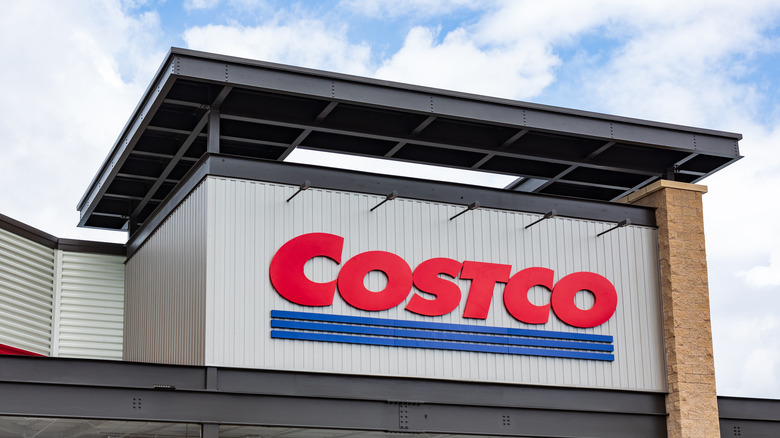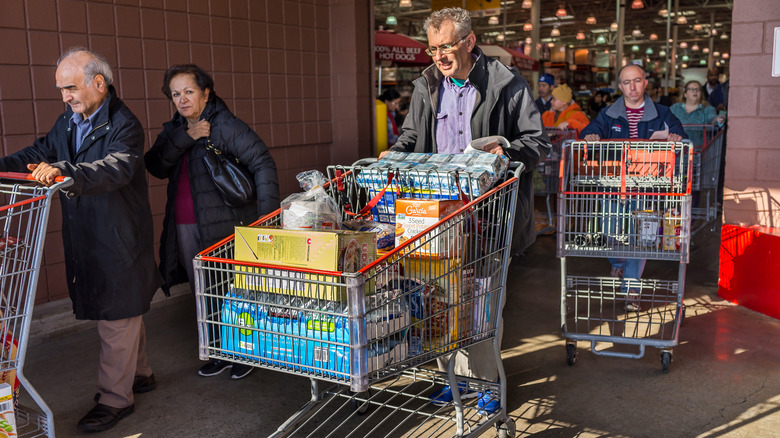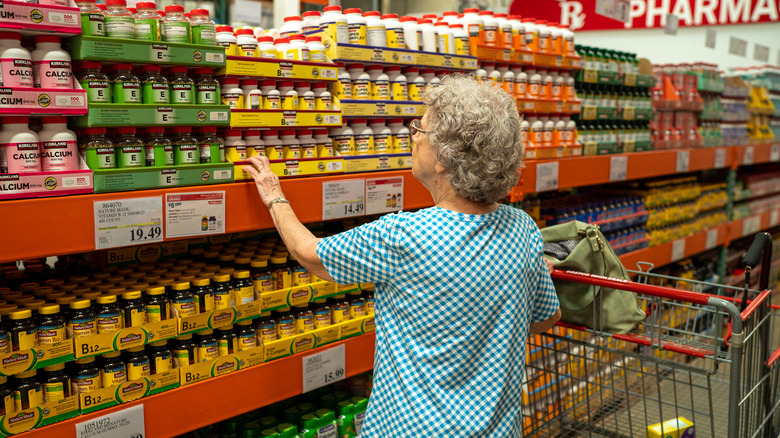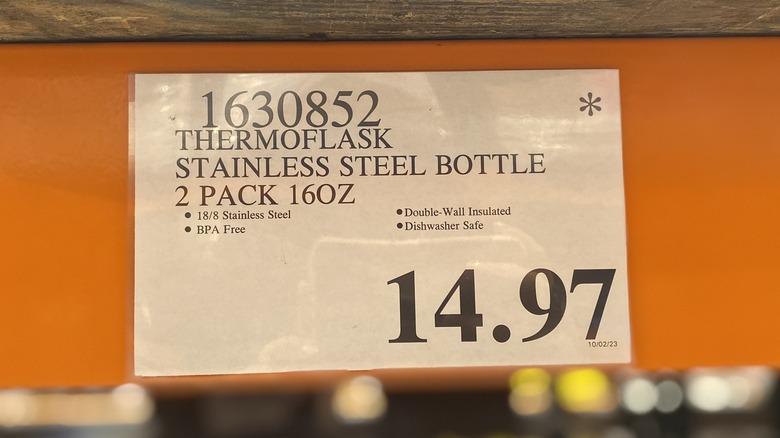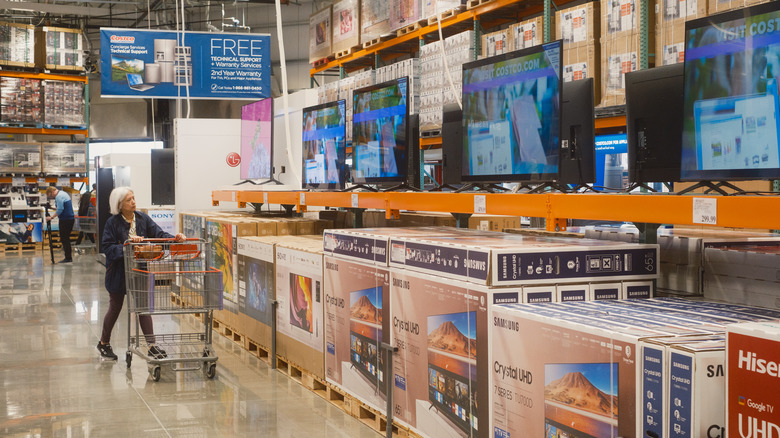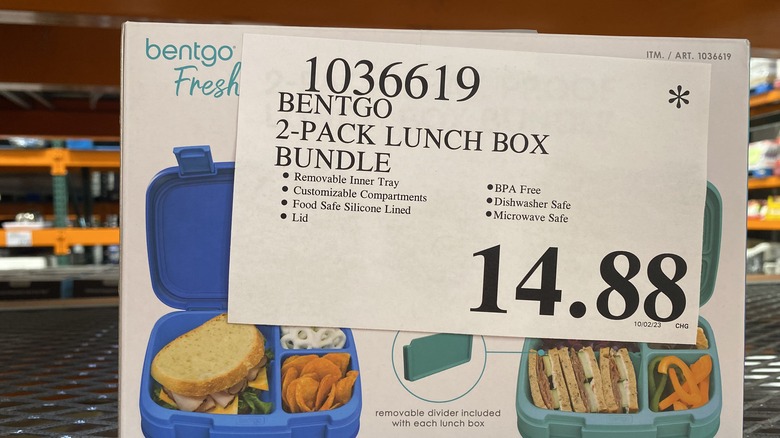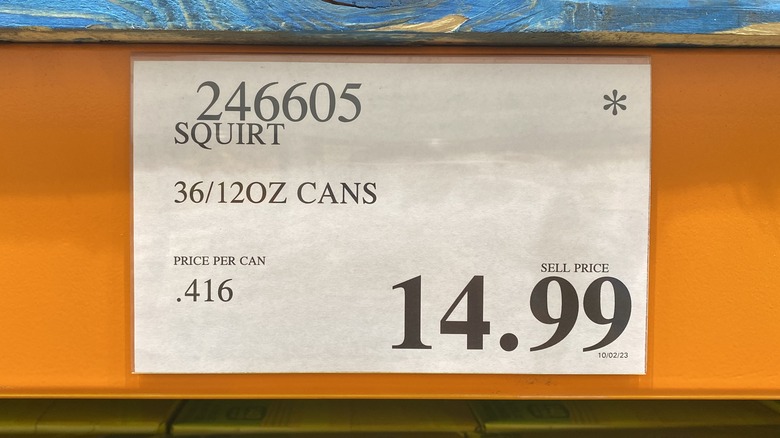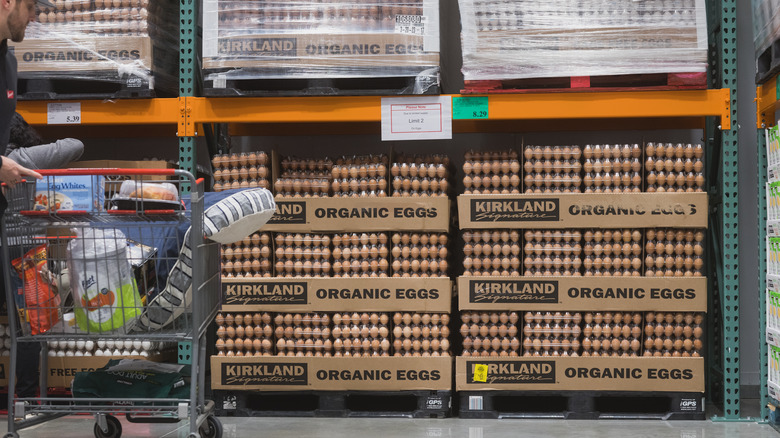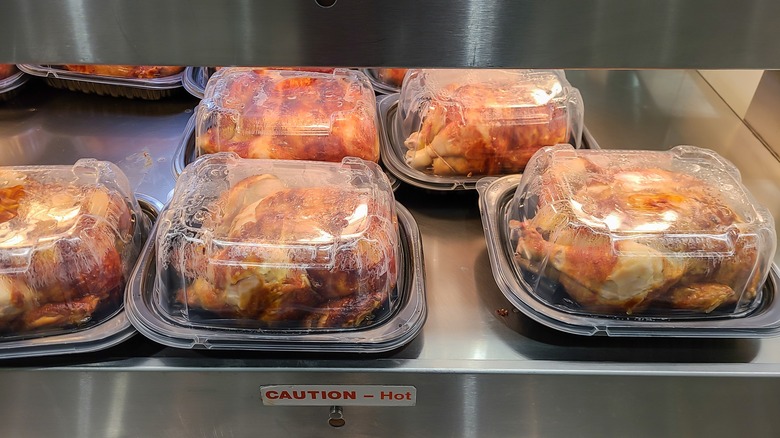How To Decipher Costco Price Tags For The Best Possible Deal
No one does "economy of scale" quite like Costco. This members-only wholesale store will have you wondering why you ever buy anything in small packages as soon as you walk in the front door, and you're almost guaranteed to leave with a few bargains under your belt — even if you've got to do the cost-per-ounce math to find it. From big (and big-ticket) items like TVs and furniture to high-quality ingredients like meat, seafood, and spices, Costco has a deal for every kind of shopper, no matter how much pantry space you have.
There are even more deals to be had once you learn the price-tag lingo. Costco insiders and employees know that every price tag has a meaning, and understanding what those seemingly arbitrary numbers mean could save you even more than you're already saving by buying in bulk. This is everything you need to know to stretch your dollars and stock up by finding the best possible deals at Costco.
Most prices end with .99
As you peruse the aisles and dodge the crowds, past the stand mixers and cult-favorite snacks, and through the Kirkland-brand clothing, you'll notice two things. First, while Costco is huge, it has way fewer items than your standard grocery store — about 4,000 compared to 30,000. It's the size of the packages that require such a big space, not the number of SKUs. Second, the majority of prices end in .99. According to Len Rapoport of Tough Nickel, merchandise with this pricing structure is at its standard price.
Costco prides itself on providing the best prices on name-brand merchandise (and even better prices on Kirkland store-brand items, which are still made by quality, reputable producers). The price per item may very well be less than you'd pay at a grocery or big box store, but that's because Costco sells large quantities in large packages. A great price, yes, but not a special deal.
Prices that end in .49, .59, and .69 mean you could be getting a deal
If you see a price ending in 9 other than .99, the manufacturer will most likely discount this item. Costco.97, which rounds up deals and discounts at Costco locations nationwide, explains that these items might be an addition to Costco's inventory, with manufacturers providing special pricing to get buyers excited about a new item. It could also represent a new package size or the return of a seasonal item.
Other insiders say you shouldn't pay these prices too much mind. Yes, they could be manufacturer discounts, but that doesn't carry as much meaning as it does at other grocery or big box stores. Just about every item is being discounted to some extent due to Costco's serious buying power. So don't shy away from these prices (again, they're almost guaranteed to be lower than you'd find at other retailers), but don't assume this pricing structure means you're getting a major deal.
Prices ending in .97 are Costco discounts – but might not be the lowest price
When a Costco location's manager is discounting the cost of items, things officially shift from "good price" to "great deal" territory. The signifier is when a price ends in .97 — a change so iconic that it inspired the name of the Costco.97 deal-spotting website. "Products with prices ending in .97 are on clearance and likely won't be sold again. These exclusive deals are not advertised, and availability varies by store and region," the site explains.
These deals are for a limited time only and may not be available at the location down the road. Prices could go back up, or the item could sell out — especially if it is seasonal. Each store's manager creates these prices, and will vary based on a given location's inventory. If you see something you love priced at .97, you may want to stock up, especially if there aren't many left. However, if inventory is still high, take a peek at the number in the bottom right corner of the price tag to see how recently the price was changed and get a clue to whether it might change again soon.
The date at the bottom right could mean nothing – or it could mean savings are on the way
The tiny date printed in the bottom right corner of each price tag is the date the price tag was printed — and possibly the last time the price was changed. Throwing in a .97 price lets buyers know a Costco location is trying to clear inventory to make room for new or seasonal items.
However, this combination doesn't necessarily mean you're getting the lowest price — yet. If there is still a lot of inventory and that date is recent, you might want to keep the item on your shopping list and come back in a few days. Chances are, the price will drop again to keep inventory moving. But don't wait too long. If the inventory is low, put the item in your cart so you don't miss your chance. Items on clearance may not come back again.
This date doesn't mean much if the item doesn't have a special price, though. Without signifiers like a .97 price or an asterisk, it's simply the date the price tag was printed and doesn't mean an additional discount is headed your way.
Keep an eye out for .00 and .88 prices
If you're looking for a serious bargain, check for .00 and .88 prices, especially at the end of a season. These super-low prices are manager markdowns designed to move the last few of a given item, like a floor model or a returned but sellable product that is about to go out of season.
Sean Sweeney (@superunsexy on Instagram) specifies that this is the lowest the price will ever be, so if you spot the grill you've been eyeing at an unbelievably low price after the snow has started to fall, now is the time to buy, because grills will be back to their normal price come spring.
But don't go wild adding these items to your oversized shopping cart as soon as you spot them. Be sure to give any item with a .00 or .88 price a once-over first. Because these have often spent weeks on the floor being tested by interested buyers, or because they may have been purchased and returned, you'll want to look carefully for any damage that might prevent you from enjoying your incredible find. Of course, Costco's amazing return policy should give you some peace of mind.
Items with tags with an asterisk won't be here for long
Now that you've mastered the .97 price tag secret, there's one more major signifier you should look for when browsing for a bargain at Costco: The asterisk. A price tag with an asterisk means the item will not be restocked and that once it's gone, it's gone. Even if the price still ends at .99, if you spot something you love with an asterisk, you'll want to put it in your cart — especially if inventory is low. If there is a lot of inventory, the price might drop again, but you might not want to miss your chance before it's gone.
And if there's one sign to stock up you should never ignore, it's a .97 price with an asterisk on the price tag. These items are marked below their original price and are not coming back. Buy now, buy as much as you can fit in your trunk, and know you're covered until you find a new favorite.
Food items with colored tags are organic, and might still be a better deal
The vast majority of price tags at Costco are white, with one exception: Organic food and drink items. These items are marked with a green price tag, making it easy to spot certified organic offerings. Costco's organic offerings extend beyond meat and produce, including things like coffee and wine.
At most grocery stores, an organic label could mean you're paying extra. At Costco, though, that isn't necessarily the case. More often than not, organic items are displayed next to or near their non-organic counterparts, making it easy to compare prices. Keep an eye out for non-.99 prices to see if either item is discounted, and be sure to look at the per-unit price. You might be surprised to find the organic choice actually costs less than the non-organic option, another benefit of Costco's buying and bargaining power.
Costco has even more ways to save
In addition to the already-low prices you get with a Costco membership and the bargain shopping you can do by decoding price tags, Costco has more ways to make saving money incredibly easy.
Some price tags highlight Instant Rebates, discounts taken at check-out that get automatically applied to your total. Unlike other price changes, these rebates are clearly marked on the price tag. You'll see the item's original price, how much the rebate is for, and the price you'll pay at the register — often highlighted in yellow, so it's extra obvious. If you're shopping online, the Costco website also makes it easy to submit manufacturer rebates for items purchased on the company's website.
Second, if you're wandering the aisles at Costco and see that something you bought last week is now on sale, you can request a price adjustment up to 30 days after your initial purchase is made. All you have to do is go to the customer service desk with your Costco card and request a refund for the difference. Just be sure to go to the same location you purchased the item, as discounted prices vary from location to location.
Don't forget the famous rotisserie chicken
Finally, a few items will always have a ridiculously low price, no matter the season or how inflation might cause other prices to rise. Those famous items are Costco's rotisserie chicken and the food court hot dog and soda deal.
The rotisserie chicken rings in at just $4.99, a price that has held steady despite shortages, avian disease outbreaks, and inflation. How? Costco owns a chicken hatchery in Nebraska and contracts with nearby farmers, meaning it doesn't have to source birds from other producers. Plus, the low price of a rotisserie chicken helps draw in customers and attract members, meaning the company profits elsewhere.
And we can't forget the $1.50 hot dog-and-soda combo (including free refills). Costco's hot dog price was set in 1985, and the founder made it clear the price should never change, all the more reason to stop for a bite in the food court on your way out. These two low, low prices ensure you'll find a deal on every trip to Costco, even if it's just a cheap lunch or a crazy-affordable dinner.
